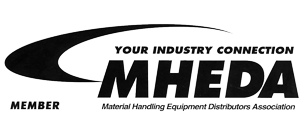What are Forklift Carriage Classes & Why Do They Matter?
October 15, 2021 - Last modified: September 23, 2021 @ 9:51 am
Understanding forklift carriage classes is more important than you may think. A fork carriage is fundamental to the forklift’s design.
Forklift forks aren’t directly connected to the mast. Instead, they attach to the forklift carriage. The forks and any other attachments are then attached to the mast chains, allowing the load to move vertically along the mast channel.
Your forklift carriage class determines which attachments you can use with your equipment. It also determines the potential lifting capacity, among other things.
Forklift Carriage Classes
There are five forklift carriage classes. These classes differ in the distance between the upper fork bar and the lower fork bar. Each class correlates with a different lifting capacity.
Keep in mind that while a forklift carriage can give you an idea of a forklift's load capacity, it is not the ultimate answer. Your forklift's data plate and load capacity chart are the only places to find accurate load capacity information.
Keep in mind that forklift carriage classes are different than forklift mast types. Learn about different forklift mast types here.
Class 1 Forklift Carriages
Class 1 forklift carriages have a carriage height of 13 inches. This correlates to a relative lifting capacity of less than 2,200 pounds.
Class 2 Forklift Carriages
Class 2 forklift carriages have a carriage height of 16 inches. These carriages generally have a lifting capacity between 2,200 and 5,500 pounds.
Class 3 Forklift Carriages
Class 3 forklift carriages have a carriage height of 20 inches. These forklifts typically lift between 5,500 and 10,998 pounds.
Class 4 Forklift Carriages
Class 4 forklift carriages have a carriage height of 25 inches. On average, they lift between 11,000 and 17,600 pounds.
Class 5 Forklift Carriages
Class 5 forklift carriages have a carriage height of 28.66 inches. They generally correlate with lift capacities between 17,602 and 24,198 pounds.

Finding the Right Equipment
If you already have a forklift, understanding your forklift carriage class will give you an idea of which attachments you can use.
If you're shopping for new equipment, consider forklift carriage classes before you buy. For instance, if there is a particular attachment you know you'll use frequently, you'll want to make sure the forklift carriage you choose is compatible with that attachment.
Understanding different forklift carriage classes will help you make an informed decision when it's time to upgrade.
To make an even smarter purchasing decision, you'll want to compare all your options upfront. Get pricing and information on a range of forklifts that fit your needs with Forklift Inventory. Check out all of your options in one place for free.
Save time and money. Shop with confidence from anywhere in the country. There's no commitment or obligation to make a purchase. Simply compare high-quality equipment from pre-screened dealers in your area.
Invest in a High-Quality Forklift Today.
Further Reading:
- Forklift Mast Types: How to Find the Best Fit
- Types of Aerial Lifts: Everything You Need to Know
- Everything You Need to Know About Hydrogren Fuel Cell Forklifts
Compare Forklift Prices
Forklift Inventory has the largest online selection of forklifts, aerial lifts and construction forklifts. Compare new and used forklifts to get the lowest prices available.




